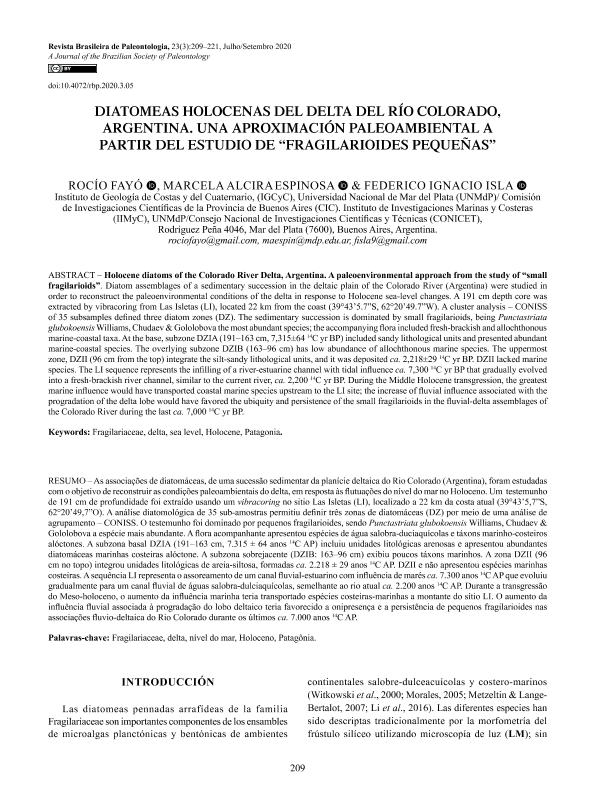Mostrar el registro sencillo del ítem
dc.contributor.author
Fayó, Rocío

dc.contributor.author
Espinosa, Marcela Alcira

dc.contributor.author
Isla, Federico Ignacio

dc.date.available
2021-06-17T20:28:54Z
dc.date.issued
2020-07
dc.identifier.citation
Fayó, Rocío; Espinosa, Marcela Alcira; Isla, Federico Ignacio; Diatomeas holocenas del delta del río Colorado, Argentina. Una aproximación paleoambiental a partir del estudio de “fragilarioides pequeñas”; Milchwissenschaft - Milk Science International; Revista Brasileira de Paleontologia; 23; 3; 7-2020; 209-221
dc.identifier.issn
1519-7530
dc.identifier.uri
http://hdl.handle.net/11336/134144
dc.description.abstract
Diatom assemblages of a sedimentary succession in the deltaic plain of the Colorado River (Argentina) were studied in order to reconstruct the paleoenvironmental conditions of the delta in response to Holocene sea-level changes. A 191 cm depth core was extracted by vibracoring from Las Isletas (LI), located 22 km from the coast (39°43’5.7”S, 62°20’49.7”W). A cluster analysis – CONISS of 35 subsamples defined three diatom zones (DZ). The sedimentary succession is dominated by small fragilarioids, being Punctastriata glubokoensis Williams, Chudaev & Gololobova the most abundant species; the accompanying flora included fresh-brackish and allochthonous marine-coastal taxa. At the base, subzone DZIA (191–163 cm, 7,315±6414C yr BP) included sandy lithological units and presented abundant marine-coastal species. The overlying subzone DZIB (163–96 cm) has low abundance of allochthonous marine species. The uppermost zone, DZII (96 cm from the top) integrate the silt-sandy lithological units, and it was deposited ca. 2,218±2914C yr BP. DZII lacked marine species. The LI sequence represents the infilling of a river-estuarine channel with tidal influence ca. 7,30014C yr BP that gradually evolved into a fresh-brackish river channel, similar to the current river, ca. 2,20014C yr BP. During the Middle Holocene transgression, the greatest marine influence would have transported coastal marine species upstream to the LI site; the increase of fluvial influence associated with the progradation of the delta lobe would have favored the ubiquity and persistence of the small fragilarioids in the fluvial-delta assemblages of the Colorado River during the last ca. 7,00014C yr BP.
dc.format
application/pdf
dc.language.iso
spa
dc.publisher
Milchwissenschaft - Milk Science International

dc.rights
info:eu-repo/semantics/openAccess
dc.rights.uri
https://creativecommons.org/licenses/by/2.5/ar/
dc.subject
DELTA
dc.subject
FRAGILARIACEAE
dc.subject
HOLOCENE
dc.subject
PATAGONIA
dc.subject
SEA LEVEL
dc.subject.classification
Paleontología

dc.subject.classification
Ciencias de la Tierra y relacionadas con el Medio Ambiente

dc.subject.classification
CIENCIAS NATURALES Y EXACTAS

dc.title
Diatomeas holocenas del delta del río Colorado, Argentina. Una aproximación paleoambiental a partir del estudio de “fragilarioides pequeñas”
dc.title
Holocene diatoms of the colorado river delta, argentina. A paleoenvironmental approach from the study of “small fragilarioids”
dc.type
info:eu-repo/semantics/article
dc.type
info:ar-repo/semantics/artículo
dc.type
info:eu-repo/semantics/publishedVersion
dc.date.updated
2021-06-10T19:28:55Z
dc.journal.volume
23
dc.journal.number
3
dc.journal.pagination
209-221
dc.journal.pais
Brasil

dc.journal.ciudad
Porto Alegre
dc.description.fil
Fil: Fayó, Rocío. Universidad Nacional de Mar del Plata. Facultad de Ciencias Exactas y Naturales. Instituto de Geología de Costas y del Cuaternario. Provincia de Buenos Aires. Gobernación. Comisión de Investigaciones Científicas. Instituto de Geología de Costas y del Cuaternario; Argentina. Consejo Nacional de Investigaciones Científicas y Técnicas. Centro Científico Tecnológico Conicet - Mar del Plata. Instituto de Investigaciones Marinas y Costeras. Universidad Nacional de Mar del Plata. Facultad de Ciencias Exactas y Naturales. Instituto de Investigaciones Marinas y Costeras; Argentina
dc.description.fil
Fil: Espinosa, Marcela Alcira. Consejo Nacional de Investigaciones Científicas y Técnicas. Centro Científico Tecnológico Conicet - Mar del Plata. Instituto de Investigaciones Marinas y Costeras. Universidad Nacional de Mar del Plata. Facultad de Ciencias Exactas y Naturales. Instituto de Investigaciones Marinas y Costeras; Argentina. Universidad Nacional de Mar del Plata. Facultad de Ciencias Exactas y Naturales. Instituto de Geología de Costas y del Cuaternario. Provincia de Buenos Aires. Gobernación. Comisión de Investigaciones Científicas. Instituto de Geología de Costas y del Cuaternario; Argentina
dc.description.fil
Fil: Isla, Federico Ignacio. Consejo Nacional de Investigaciones Científicas y Técnicas. Centro Científico Tecnológico Conicet - Mar del Plata. Instituto de Investigaciones Marinas y Costeras. Universidad Nacional de Mar del Plata. Facultad de Ciencias Exactas y Naturales. Instituto de Investigaciones Marinas y Costeras; Argentina. Universidad Nacional de Mar del Plata. Facultad de Ciencias Exactas y Naturales. Instituto de Geología de Costas y del Cuaternario. Provincia de Buenos Aires. Gobernación. Comisión de Investigaciones Científicas. Instituto de Geología de Costas y del Cuaternario; Argentina
dc.journal.title
Revista Brasileira de Paleontologia

dc.relation.alternativeid
info:eu-repo/semantics/altIdentifier/url/https://sbpbrasil.org/publications/index.php/rbp/article/view/163
dc.relation.alternativeid
info:eu-repo/semantics/altIdentifier/doi/https://doi.org/10.4072/rbp.2020.3.05
Archivos asociados
